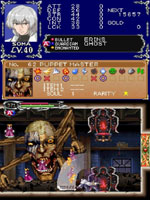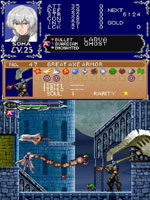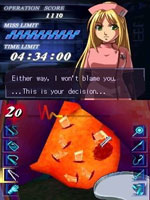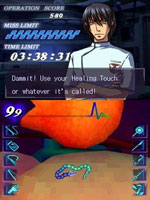
Tales Of Blood For the Nintendo DS 101
- Title: Castlevania: Dawn of Sorrow
- Developer: Konami
- Publisher: Konami
- System: DS
- Reviewer: Zonk
- Score: 9/10
Though there is a Belmont in the story, the protagonist of this particular quest to end undeath is Soma Cruz, the near-Dracula from Aria of Sorrow. The game doesn't mess around, quickly tossing you into the midst of a cult headquarters crawling with creepy not-living things. The cult, led by an overly enthusiastic woman of darkness, is dedicated to reviving Dracula by offing Soma. Their headquarters is a re-envisioning of the classic castle, and their minions take every shape and size you would expect. Zombies lurch, worgs howl, and witches fly from every corner of the 2D field in an attempt to end your existence. This diversity of monsters comes in handy, because Soma actually has the ability to consume the souls of his defeated opponents. By consuming souls, you gain some of the critter's abilities. The witch soul, for example, lets you shoot a deadly cat projectile, while the spear guard lets you twirl a spear quickly about you. Souls have numerous uses, and by stealing more of them you become more adept at the soul's power. This "catch-em-all" aspect to the gameplay adds a fun element of randomness to what would otherwise be the usual slog through endlessly respawning baddies.
Souls can be equipped via an RPG-like interface, and you can have three equipped at any one time. In addition to souls, you have gear. You have many choices of modern and antique weapons, as well as armor and accessories. Diablo 2 it isn't, but along with the simple stat modifying trinkets you gain experience from slaying baddies. Experience points, of course, leads to leveling up. The more Soma fights, the more powerful he becomes. Adding another layer of complexity, some souls can be combined with certain pieces of equipment to make them even more powerful. You don't have access to them while they're fused, but you can release them again if you start to miss your mojo. A short while into the game you gain the ability to swap two sets of equipment at the touch of a button, allowing you an 'agile' set and a 'boss' set if you're so inclined. None of these elements are groundshakingly new, but they hang together very well and the resulting gameplay adds a thoroughly enjoyable level of depth to the traditional 2D gaming.The touch-screen does see some use during the course of the game: at the end of the incredibly dramatic Boss battles. During the course of the game you find mystical seals that can be used to destroy the epic enemies scattered throughout the title. These seals are simple symbols that must be drawn on the touch-screen once you've lowered the boss's health sufficiently. It feels a little clumsy to quickly pull out the stylus at the end of a Boss fight, but it does switch up the gameplay a bit. Thankfully, Boss fights aren't mindbreakingly hard. They're challenging, but once you've learned a particular head critter's pattern they'll go down quickly enough.
Dawn of Sorrow may not be the most challenging Castlevania title to ever cross a nostalgic gamer's path, but it is a lot of fun. Level design is linear, with your trusty top screen map guiding you and reminding you where you've been. If you've played a 2D explorer in the Metroid style before you're not going to encounter many surprises, but the game doesn't go out of its way to explain the route for you. Backtracking and a small amount of headscratching will be needed to get you where you need to be. As new abilities open up, new parts of the map become available to your thirsty blade. This exploration element is something that just doesn't happen in games much anymore, and it was a lot of fun having to work out for myself the way forward in the dusty hallways of the cult lair.
Dusty hallways they may have been, but they looked tremendous. Hands down the most enjoyable aspect of Dawn of Sorrow is its impressive production value. While the touch-screen elements of the DS get short shrift its graphical capabilities are put on display, adding multiple levels of depth to the background locations you carve your way through the game. Some levels extend on for miles, while others feature details you may never have expected to see in a 2D title. Leaping on top of a van in one level, for instance, causes the vehicle to creak and tilt in your direction and the snow atop the roof to fall off. Creature design is also tremendous as a result, with even lowly one-hit skeletons having a lot of personality to them. Mini-bosses and Boss battles are epic encounters as the console can make the most of giant-scaled beasts. The auditory experience is just as enjoyable, with a funky melody for each area and some truly haunting themes orchestrated for important story moments. Sound effects have a slightly digital edge that just lets you know you're playing a Castlevania game. The whole package comes together wonderfully, making this easily the most immersive 2D Castlevania experience to date.If you've ever played a 2D Castlevania title before, Dawn of Sorrow is going to bring back a lot of happy memories. There is a lot of fun to be had bashing in the dusty brainpans of the restless dead. My only real complaint with the title is that it doesn't do as much with the touch-screen and when it does the usage is sort of clumsy. Despite that minor issue, this is a worthy successor to the Belmont family's legacy. It even has replayablity in the form of an alternate character mode. Once you've defeated the game you can go back through the title with the ability to switch off between Julius Belmont and some other NPCs. There's also some limited multiplayer aspects, though they're nothing to write home about. Dawn of Sorrow is an extremely enjoyable 2D title, and categorically proves to any doubters that there is plenty of life left in the 2D perspective.
- Title: Trauma Center
- Developer: Atlus
- Publisher: Atlus
- System: DS
- Reviewer: Zonk
- Score: 7/10
Derek Stiles is a newbie to the field of surgeon, and it shows. His cocky attitude nearly gets a patient killed, but he manages to regain his confidence when he's the only one who can save a desperately wounded patient after an accident. He accomplishes this medical marvel with 'The Healing Touch', a semi-mystical ability that lets him slow down time. Throw in enough dramatic text boxes to rival an RPG and an ironically named bioterrorism agent called GUILT and you have the makings for an extremely unique storyline.
The gameplay itself focuses on what happens inside the patient. You're given several tools to ply your trade, including a scalpel, laser, suturing needle, and some hi-tech antibiotic gel. After opening the patient, you're presented with your task for the puzzle. Each one is slightly different and requires a specific technique to resolve. The procedures are introduced to you at the beginning of the game, but once you're in the thick of the over-the-top plot you're going to have to remember exactly how your nurse told you to deal with the issue at hand. For example, in order to remove a tumor you have to find it with ultrasound, cut it open, drain the fluid, cut it off, remove the tumor, place an antiseptic skin patch, disinfect the patch, and rub it into place. And that's just one tumor. Many puzzles require you to remove a series of tumors, and once the bioagent starts affecting the city some of the tumors move. It's all very disconcerting. In addition to following procedures and keeping your eyes open for complications, you'll be racing against two countdowns. One is a simple timeclock, a time limit that you can't exceed so as not to endanger your patient. The other is the ever-falling number that represents your patient's vital signs. This score drops when you cut into someone and can be increased via the use of an injection. The injection, though, takes time away from following the procedure and getting the surgery done. In order to succeed in Trauma Center you have to have a good memory and be very quick. The experience, if you have a strong enough stomach, feels wholly unique.
The problem, though, is that it's a very stressful experience. I'm not a dedicated puzzler, but I'm no slouch either. Trauma Center requires you to move so quickly, at times, that you'll find yourself tempted to use your DS as a batarang in frustration. Especially once you're deep into the storyline, expect to have to repeat surgeries over and over as you fine-tune your procedures and race against the clock. The time slowing healing touch helps a lot, but even with the time slowdown you can quickly find yourself overwhelmed by the pace of exploding veins or bleeding wounds.
Visually, the title could have been torn from the pages of a high quality manga. The characters are all well drawn, and while there is no animation per se to the upper screen storyline there is still a great sense of movement to the primary players. The squishy innards of the lower screen look pretty good too. They're certainly gory enough for the subject matter. Blood oozes and seeps, and the first time you find yourself having to pull glass from a victim's subdermal layer you'll find yourself wincing. The dialogue and music could have been pulled from an anime as well. Every pre-surgery session involves Derek posing mightily and shouting, "Let's begin the operation!" The music ramps up during surgery and heightens the already tense mood as you eye the clock and try desperately to keep the patient from bleeding out on the operating room floor. There isn't a whole lot to the audio environment here, but what there is works.Overall, Trauma Center is a unique experience. Anime-inspired elements combine with varied puzzle action to produce a creation that could only work on the DS. Aside from the sometimes frustrating difficulty, the story mode is brief, leaving you wondering about the future of the young Dr. Stiles. Re-playability is available in the form of challenge modes, where you can go back and re-do previously successful surgeries for higher marks. If you're looking for a challenging puzzle game that will get you weird looks on the subway train, Trauma Center: Under the Knife will make the med student in you very pleased.





We can have book reviews... (Score:2)
Really though, I'm all over Castlevania. Haven't bought one of those since Circle of the Moon, but this one looks too sweet to pass up. I'm not so sure I'd even want to play a game about performing high-pressure surgery, but I think it's really cool that such a game exists. A gory game about saving lives... kinda refreshing, eh?
Decent prospects (Score:5, Interesting)
As for Trauma Center, I, personally, use my hand held consoles on buses and trains, though. So I'm not all that keen to play a game of steady-handedness on public transportation. And when I'm at home, I'm not much of a fan of hunching over a tiny screen for it.
Re:Decent prospects (Score:5, Interesting)
Re:Decent prospects (Score:2)
Re:Decent prospects (Score:1)
Re:Decent prospects (Score:1)
Re:Decent prospects (Score:2)
Trauma is more of a puzzle game than a surgeon simulator. You don't have to be super accurate with it. I haven't played it on a bus, but I imagine it's not that B of D.
One thing that I will say about it that's kinda annoying is that you do spend a bunch of time going through the 'story mode'. I really wish the developers had mo
Re:Decent prospects (Score:2)
Re:Main page? (Score:1)
Re:Main page? (Score:2, Insightful)
Re:Main page? (Score:1)
Re:Main page? (Score:3, Interesting)
Re:Main page? (Score:2)
False, the Gameboy Advance Castlevanias are fairly popular. Castlevania is, actually, one of the classic series that's stayed closest to its roots, although they did mix in a healthy portion of Metroid. Even so, almost every Metroid-like Castlevania game contains a mode that lets you play as a whip-wielder.
Re:Main page? (Score:1)
Actually, I've played the first few Castlevanias on the old 8/16-bit plats. I'm not saying they suck, but Christ... I'm a big fan of Sonic the Hedgehog, but I DON'T EXPECT TO SEE REVIEWS OF SONIC GAMES ON THE MAIN PAGE OF SLASHDOT.
narf.
Stressful experiences... (Score:3, Interesting)
Re:Stressful experiences... (Score:1)
girls=money^2, money=root(evil), therefore money^2=evil and girls=evil.
Re:Stressful experiences... (Score:1)
I can only manage 2-3 operations in a session and then I have to switch games =)
Re:Stressful experiences... (Score:1)
Re:Stressful experiences... (Score:2)
AARRRGH! I can't get past Episode 2 Suregery 2
With the little invisible nodes that you have to ultra sound and then pinch and then cut and drain... Anyone know any good strategy guides or walk throughs? I almost threw my DS too.
Trauma Central (Score:2, Insightful)
Re:Trauma Central (Score:2)
Life and Death convinced me that I couldn't be a surgeon. Surgery with only the keyboard and EGA graphics is....challenging!
Re:Trauma Central (Score:2, Interesting)
This game is a must! (Score:1)
Remember: Only the sunlight can kill a vampire!
Re:This game is a must! (Score:2)
The best part of it is the souls systems, I think. Other than the great "catalogue" of them (which, combined with the % explored is, for some pyschological reason, huge incentive for me to "find everything"), the way you acquire them was pretty cool, too; there was only a certain chance each time you killed a monster. So with intermittent reward, I was killing Aqua m
Re:This game is a must! (Score:3, Informative)
While there could very well be a precedent in myth, I think most of this sunlight killing vampires business started with the silent movie Nosferatu.
Re:This game is a must! (Score:1)
Re:This game is a must! (Score:3, Funny)
Old school difficulty (Score:5, Interesting)
Some of the missions have small tricks also so you have to think a little. It's not always just about moving faster, but doing things in a certain order. All the same, it's still mostly about your own hand-eye coordination skill.
I personally found it refreshing as games seem too scared to do things this way anymore. I consider the difficulty of Trauma Center one of the best aspects of its design.
Variable difficulty design would be better (Score:1)
Some backtracking? (Score:5, Informative)
Re:Some backtracking? (Score:1)
Re:Some backtracking? (Score:2)
Re:Some backtracking? (Score:1)
My opinion of Castlevania (Score:4, Interesting)
The stylus additions were totally unnecessary and really felt added on just to use the feature. Having a map/info up all times on the second screen was nice, but they really should have used the top (nicer) screen for gameplay, and the bottom (not so clear) screen for the map. If they took out the dumb stylus stuff they easily could have done this.
Also if it was on the GBA then I wouldn't have had to deal with the bulky DS which makes my hands hurt after I play for a couple of hours. It really is uncomfortable for me.
Other than those small details the game is typical, excellent Castlevania action.
Re:My opinion of Castlevania (Score:2)
Well, it kind of already was a GBA title, three of them actually (Circle of the Moon, Harmony of Dissonance, Aria of Sorrow). Dawn of Sorrow doesn't really have much to set it appart from the rest, it feels pretty much like Aria of Sorrow just with improved graphics and new levels, even the enemies are for large part identical. However overall I like Dawn of Sorrow, it looks a lot better then the GBA titles, and while the stylus stuff doesn't add that much to the gameplay
Re:My opinion of Castlevania (Score:3, Insightful)
Re:My opinion of Castlevania (Score:1)
Huh? (Score:1)
How does the Nintendo DS hinder a developer's ability to recreate game experiences with a classic feel...? I don't get it...
Re:Huh? (Score:1)
Speaking of that, can't wait for Sonic Rush...
Castlevania (Score:5, Insightful)
Anyone who's played the original Castlevania on the NES will also be very pleased with one section of the map which pays tribute to the first level in the classic release. I was smiling all through that section.
If you go through an alternate ending, you'll get the Julius play mode. I believe he was from an SNES release. But you get to play with the whip and the character is much quicker and responsive. The gameplay is a bit different -- with no seals, souls, or ability to use potions to regain health -- so it is like a separate game altogether.
Grat game all around.
Julius (Score:3, Informative)
It wasn't the first time in the Castlevania series you had to fight a Belmont (SoTN, Circle of the Moon, Lament of Innocence - the doppleganger -), but it certainly was the most exciting. Everytime
Oops... (Score:1)
Re:Julius (Score:2)
Re:Julius (Score:2)
Re:Julius (Score:2, Informative)
Re:Julius (Score:2)
Re:Julius (Score:2)
Agree. Better than SotN. (Score:2)
Don't expect any changes (Score:1, Insightful)
Hell, this is the site with an editor who abuses the front page [slashdot.org] to whine about his videogame name getting taken away when he clearly violates the rules for using a title in his name. Did he want an exception or something because he's Rob Malda of Slashdot?
Seven years ago, Slashdot was FANTASTIC for technical computer and science news, and also the oddball int
Wish digg.com would actually work... (Score:1)
The connection to the server was reset while the page was loading."
If a single post on Slashdot in the comments section can kill it, then I don't think it'd handle the load that Slashdot handles. I think a better solution would be to kill the current
However I do want to look at it, so please can the mass migration stop for a minute so the site will actually load?
Either that, or there simply isn't a route to their server fro
Re:Please, no more game reviews (Score:1)
Why limit ourselves with a 2D world? (Score:2)
In other words, we don't need 3D first-person views to enjoy a 3D world. An interesting example of this was the "project firestart" game for the C64, even when it was "2D", I had to make 3 topdown maps for the game (a map for each floor). If I didn't look well, I could get lost in dangerous alleys f
Re:Why limit ourselves with a 2D world? (Score:1)
It can make a 2D game much more interesting without requiring massive hardware. Also because you aren't doing too much with the hardwar
Re:Why limit ourselves with a 2D world? (Score:2)
It's statements like this that make me very glad that Konami realized a part of this, and released Gradius 5 for the PS2. This is a truly visually stunning game, in my opinion,
Re:Why limit ourselves with a 2D world? (Score:1)
I'll have to check out Gradius V when I find a copy for sale. I love this type of game for instant gratification shoot-em-up action.
Re:Why limit ourselves with a 2D world? (Score:1)
You can check out www.shmups.com for a fairly comprehensive guide to shoot 'em ups.
Re:Why limit ourselves with a 2D world? (Score:2)
There are some optional areas in the new game as well, although they aren't as extensive as the Forbidden Zone. Still, the idea that there are secret transportation and barrier-breaking uses for some souls is definitely back, and they don't seem as arbitrary this time.
The most important optional zone contains its own boss, and it's greatly recommen
Re:Why limit ourselves with a 2D world? (Score:1)
Re:Why limit ourselves with a 2D world? (Score:2)
The clue I found (which I didn't use, I ended up going to a FAQ too) was one of those that the guys waiting at the castle entrance give you, you know if you talk with them sometimes throughout the game, eventually one of 'em (I think it was Mina) will drop a hint left by Alucard about one of the game's secrets.
Re:Why limit ourselves with a 2D world? (Score:1)
Re:Why limit ourselves with a 2D world? (Score:2)
Er. Well, they are there, that's settled. It's difficult to tell what they are, they're scattered around the place, and they're in a room with a cavern tileset so it's easy to mistake them for bits of detail, but they quite obviously, upon close examination of the pictures and the game graphics, supposed to represent the transformations that Soma can undergo when he uses the Curly, Devil and Manticore souls.
I'm still not sure it's exactly a fair
Trauma Center = A+ (Score:3, Interesting)
The exercise of "virtually" operating on someone turns out to be GUT WRENCHING. I mean, I have a new respect for sugeons and what they do. They must have nerves of steel.
And that moment, that moment when you first pick up a scalpel and you are told "cut them open, we're going in"... there is an unbelievable psychological barrier you have to overcome. "My god, I'm going to cut this person, and they trust me to do it".
Am I being overly dramatic? No... I have been playing video games for 20 years and am hard pressed to think of another game that made me so concerned for the well-being of NPCs. Its spooky...
oh god, i'm a dork (Score:1)
the student witch fires off a cat.
but yeah, DoS is a good game.
Stylus uses in Castlevania (Score:2)
A lot of games are requiring odd mixed use of the touchscreens these days, and I'm still iffy on using both controls. Metroid Pr
Re:Stylus uses in Castlevania (Score:2)
Re:Stylus uses in Castlevania (Score:2)
And Flying Armor? Used it like 4 times
Re:Stylus uses in Castlevania (Score:2)
Re:Stylus uses in Castlevania (Score:2)
Use your finger! I do. (Score:2)
Re:Use your finger! I do. (Score:2)
Re:Stylus uses in Castlevania (Score:1)
Not all DS games need to use the touch screen (Score:3, Insightful)
So, you want more touch screen usage or less? Frankly, I think it's not helping game quality if we criticise DS games for not using all DS features. The two screens help a lot with Castlevania, so the DS already makes a difference. I can't see any reason why the game would need to have more touch screen support, it's quite perfect as it is.
Some games use more DS features than others. We should judge games on their quality and on how much fun they are, not on how much DS features they support - although obviously, interesting usages of uniqute DS features are always worth mentioning :-)
Both of these games are excellent, by the way.
too little, not good enough, Alvy? (Score:1)
Using the magnifier in Trauma Center (Score:1)